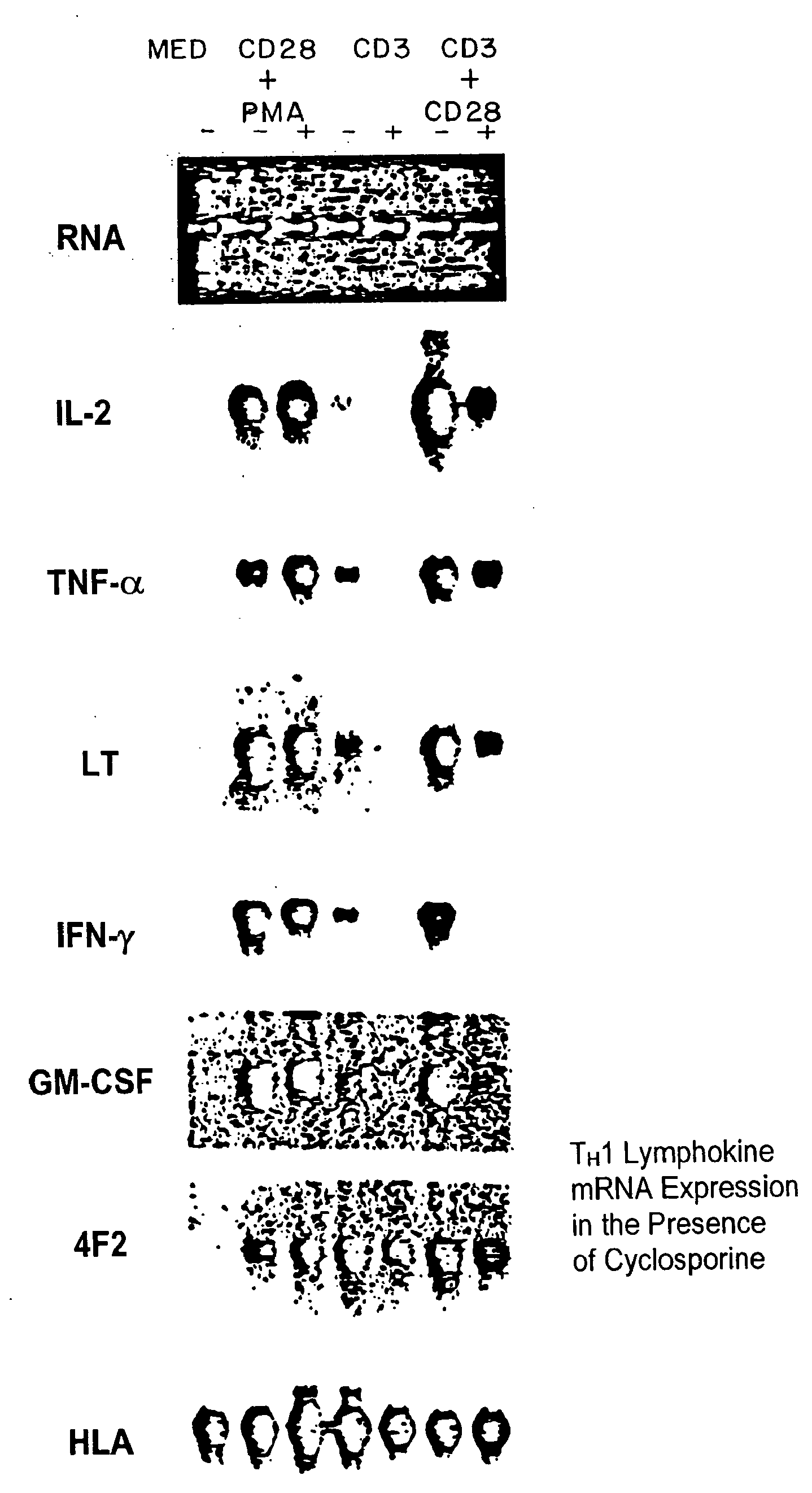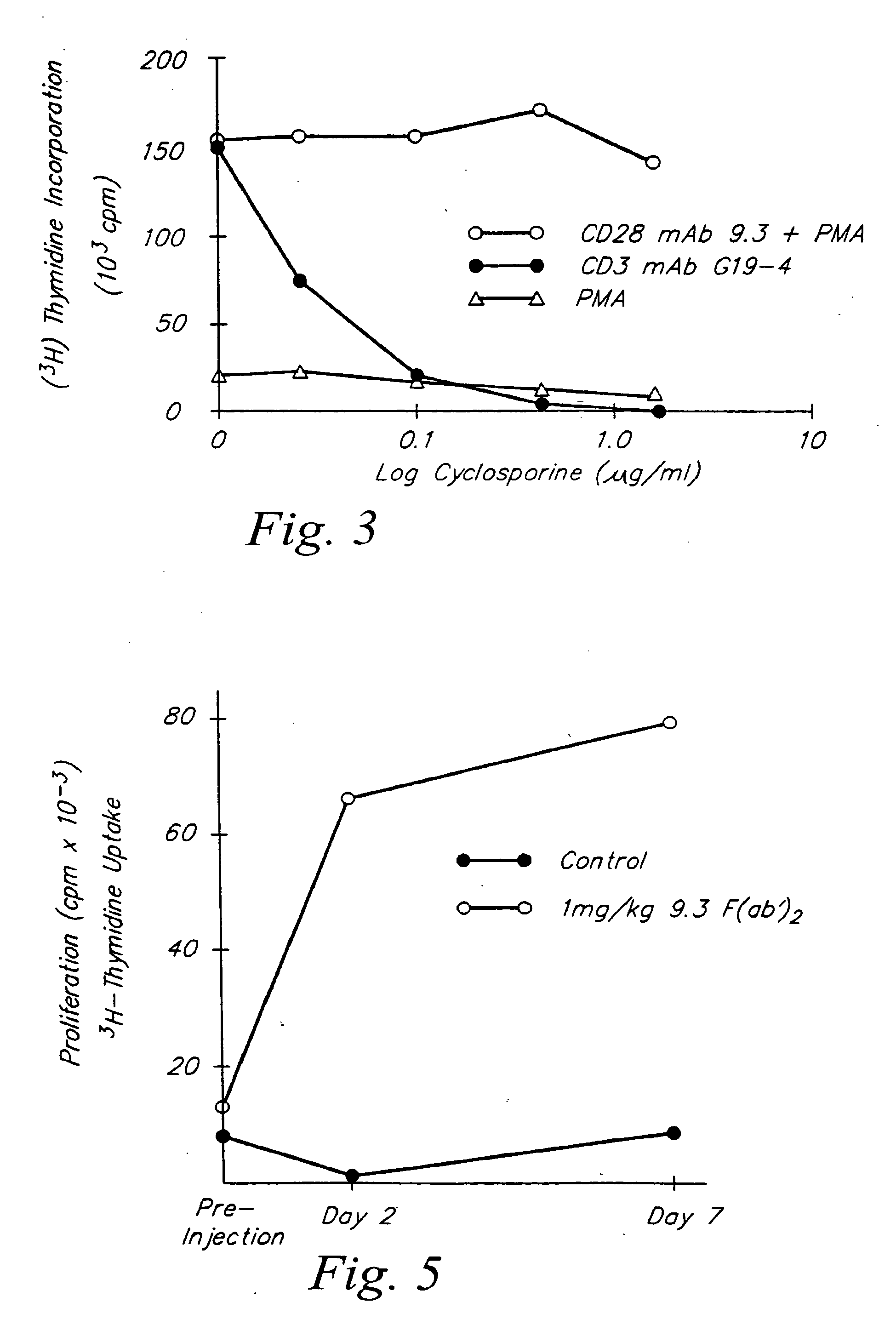Methods of treating autoimmune disease via CTLA-4IG
a technology of autoimmune disease and ctla-4ig, which is applied in the field of immunotherapy, can solve the problems of limited induction of t cell effector functions and lymphokine production, and achieve the effects of increasing levels and production, increasing t cell proliferation, and augmenting or boosting the immune respons
- Summary
- Abstract
- Description
- Claims
- Application Information
AI Technical Summary
Benefits of technology
Problems solved by technology
Method used
Image
Examples
specific example i
Preparation of CD28 Stimulator Monoclonal Antibody 9.3
[0086]The monoclonal antibody (mAb) 9.3, an IgG2a monoclonal antibody which binds to the extracellular domain of the CD28 molecule, was produced by a hybrid cell line originally derived as described by Hansen et al., Immunogen., 10:247-260 (1980). Ascites fluid containing high titer monoclonal antibody 9.3 was prepared by intraperitoneal inoculation of 5−10×106 hybrid cells into a Balb / C×C57BL / 6 F1 mice which had been primed intraperitoneally with 0.5 ml of Pristane (Aldrich Chemical Co., Milwaukee, Wis.). The monoclonal antibody 9.3 was purified from ascites fluid on a staphylococcal protein-A sepharose column as described by Hardy, R., “Handbook of Experimental Immunology,” Ch. 13 (1986).
[0087]Prior to use in functional assays, purified mAb 9.3 was dialyzed extensively against phosphate buffered saline (KCl 0.2 grams / liter dH2O; KH2PO4 0.2 grams / liter dH2O; NaCl 8.0 grams / liter dH2O; Na2HPO4.7H2O 2.16 grams / liter dH2O) and then...
specific example ii
Isolation of CD28+T Cells
[0088]Buffy coats were obtained by leukopheresis of healthy donors 21 to 31 years of age. Peripheral blood lymphocytes (PBL), approximately 2.5×109, were isolated from the buffy coat by Lymphocyte Separation Medium (Litton Bionetics, Kensington, Md.) density gradient centrifugation. The CD28+ subset of T cells was then isolated from the PBL by negative selection using immunoabsorption, taking advantage of the reciprocal and non-overlapping distribution of the CD11 and CD28 surface antigens as described by Yamada et al., Eur. J. Immunol., 15:1164-1688 (1985). PBL were suspended at approximately 20×106 / ml in RPMI 1640 medium (GIBCO Laboratories, Grand Island, N.Y.) containing 20 mM HEPES buffer (pH 7.4) (GIBCO Laboratories, Grand Island, N.Y.), 5 mM EDTA (SIGMA Chemical Co., St. Louis, Mo.) and 5% heat-activated human AB serum (Pel-Freez, Brown Deer, Wis.). The cells were incubated at 4° C. on a rotator with saturating amounts of monoclonal antibodies 60.1 (an...
specific example iii
Increased Cellular Production of Human THCD28 Lymph Kines by CD28 Stimulation by Monoclonal Antibody 9.3.
[0089]A. Increased Production of IL-2, TNF-α, IFN-γ and GM-CSF.
[0090]CD28+ T cells were cultured at approximately 1×105 cells / well in the presence of various combinations of stimulators. The stimulators included phorbol myristate acetate (PMA) (LC Services Corporation, Woburn, Mass.) at 3 ng / ml conc.; anti-CD28 mAb 9.3 at 100 ng / ml; anti-CD3 mAb G19-4 at 200 ng / ml which was immobilized by adsorbing to the surface of plastic tissue culture plates as previously described by Geppert, et al., J. Immunol., 138:1660-1666 (1987); also Ledbetter, et al., J. Immunol., 135: 2331-2336 (1985); ionomycin (Iono) (Calbiochem., San Diego, Calif.) at 100 ng / ml. Culture supernatants were harvested at 24 h and serial dilutions assayed for the presence of THCD28 lymphokines.
[0091]Specifically, IL-2 was assayed using a bioassay as previously described by Gillis et al., Nature, 268:154-156 (1977). One...
PUM
| Property | Measurement | Unit |
|---|---|---|
| Solubility (mass) | aaaaa | aaaaa |
| Inhibition | aaaaa | aaaaa |
Abstract
Description
Claims
Application Information
 Login to view more
Login to view more - R&D Engineer
- R&D Manager
- IP Professional
- Industry Leading Data Capabilities
- Powerful AI technology
- Patent DNA Extraction
Browse by: Latest US Patents, China's latest patents, Technical Efficacy Thesaurus, Application Domain, Technology Topic.
© 2024 PatSnap. All rights reserved.Legal|Privacy policy|Modern Slavery Act Transparency Statement|Sitemap



